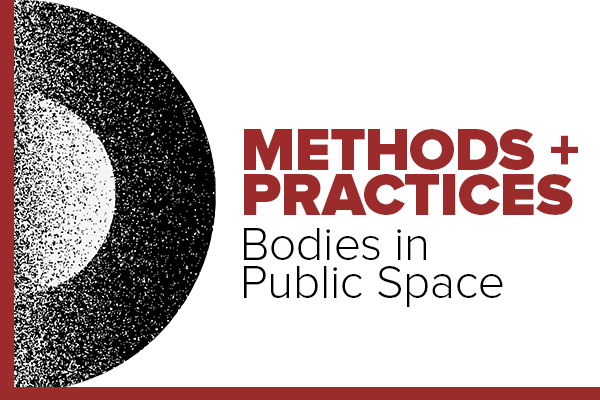
Due to the pandemic, arts and humanities practices have adapted to spatial upsets in their disciplines, affording opportunities to experiment with public spaces, outdoor spaces and ways for human interaction to be physically distanced with and without hybrid variables. In June 2020, GAHDT sponsored the first Methods Conversation, “Bodies in Virtual Space,” sharing several practitioners’ ways of grappling with the digital spaces for their work. In our second Methods Conversation, “Bodies in Public Space,” we seek a new understanding of both public and intimate spaces and will share ways of “bridging distance” with new configurations of space. We ask how to meaningfully and safely navigate the public spaces of arts and humanities methods and practices, and what happens with the increased visibility and vulnerability of the practitioners.
Event format
1 p.m. | Formal Program begins
1-1:15 p.m. | Opening remarks and Presenter Introductions
1:15-1:45 p.m. | Panel presentations
1:45-2:15 p.m. | Moderated discussion
2:15-2:20 p.m. | Closing remarks
Accessibility
To ask questions about accessibility or request accommodations, email Program Coordinator Breanne LeJeune at lejeune.16@osu.edu. At least one weeks' advance notice will help us to provide seamless access, though we will strive to meet all requests, regardless of when they are submitted.
Moderators
SUSAN VAN PELT PETRY | GAHDT Faculty Fellow and Professor (Department of Dance)
AMY SHUMAN | GAHDT Faculty Fellow and Professor (Department of English)
Panelists
KATHERINE BORLAND | Associate Professor (Department of Comparative Studies) and Director of the Center for Folklore Studies
Borland will sketch the difference between her university-based experience of transferring engagement strategies completely online and a more varied set of adaptations among community-based professionals and volunteers. A series of Zoom interviews with community activists and artists conducted in autumn 2020 revealed they had developed a broad set of in-person approaches to continuing their work during the pandemic. Paradoxically, university travel restrictions as well as the ubiquity of technology at the university curtailed the development of creative, socially-distanced, in-person approaches to engagement.
GALEY MODAN | Professor (Department of Linguistics)
Modan will discuss her research methods during COVID-19 in terms of both how particular methodologies put differential strain on differently positioned participants, and how in-person methodologies adapted to virtual formats played out differently with different participants. Additonally, she discusses the flip side — her experiences as a research subject in a 6-month NIH study on mental health during COVID-19. In bridging these issues, she will open up a conversation about how to engage with questions of what kind of research can be done and what kind of research should be done, in times of crisis.
CRYSTAL MICHELLE PERKINS | Assistant Professor (Department of Dance)
Perkins will trace methods of creating and composing in public and private spaces during times of shifting and crisis. She will share the processes of Litany and Freedom Practice(s) — two dance repertory experiments that challenge our notions of research and survival. What are our modes of transmission when sudden shifts in proximity, safety, and politics necessarily adjust our intentions and expectations?
SUZANNE SILVER | Associate Professor (Department of Art)
Silver will talk about artists’ bodies in public space immediately before shutdown and trace artists’ bodies in space during the pandemic through experiments in ERASURE, an advanced drawing course she co-taught with Professor Richard Fletcher (AAEP) last autumn that investigated drawing and erasure as daily embodied practices in both art and society.
